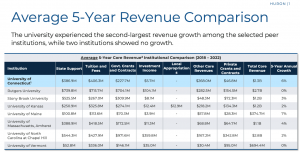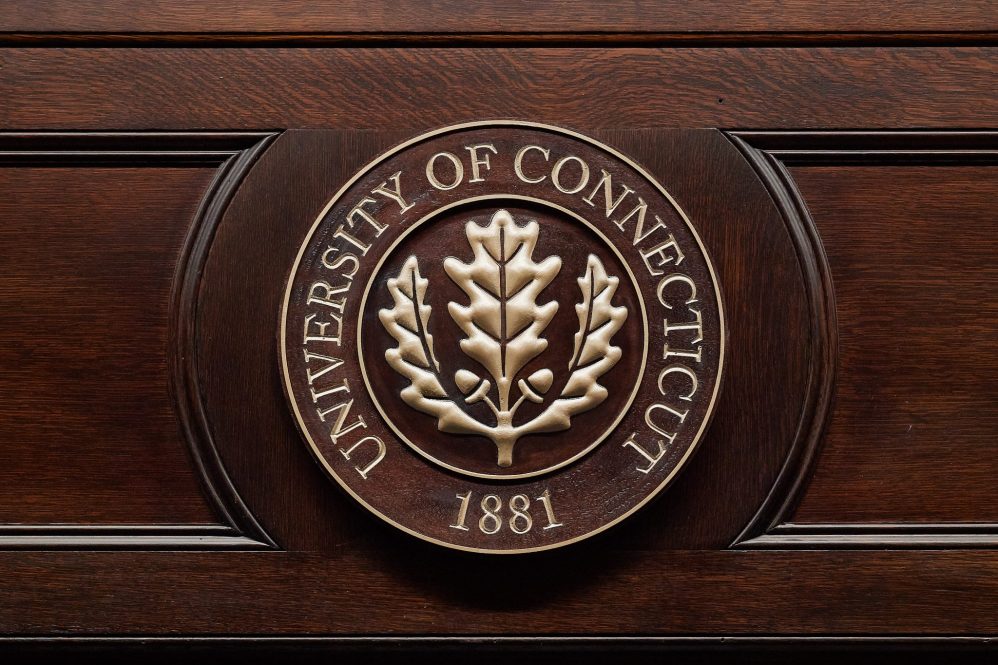Co-Chairs, Ranking Members, and Members of the Committee, thank you for giving us the opportunity to update you on our budget request and the transformative accomplishments that you have made possible at the University of Connecticut. I’m Radenka Maric, President of the University of Connecticut, and with me today is Dr. Bruce Liang, interim CEO of UConn Health and Dean of the Medical School, Anne D’Alleva, Provost, Jeff Geoghegan, Chief Financial Officer for UConn and UConn Health, and Nathan Fuerst, Vice President, Student Life and Enrollment.
I would like to thank each of you for your leadership, dedication, and support. I would also like to thank the governor, Secretary Beckham, and others in the administration who continue to work closely with UConn.
UConn is a top public university because of the state’s continued support and investment. Thanks to your support UConn provides an exceptional return on that investment:
- UConn is currently ranked #9 among public universities by the Wall Street Journal due to our affordability, average time to degree – which is the best in the nation – and the value a UConn education adds to graduates’ salaries.
- We have received more than 57,000 applications and counting for next fall – a record.
- According to the most recent UConn Economic Impact Study using the REMI methodology, UConn contributes $7.8 billion to the state’s economy. Every dollar invested in UConn by the state generates $1.40 in total economic output through additional job creation, business revenue growth, increases in household incomes, and other multiplier effects; $0.91 of every state dollar invested in UConn translates directly into net new value for Connecticut’s economy, expanding statewide GDP through increased productivity, innovation, and human capital development; UConn’s activities are responsible for generating $625 million in state and local taxes in Connecticut; and UConn supports more than 46,600 Connecticut jobs.
- For ’22 – ’23 graduates, 75% of employed in-state graduates are working in Connecticut which represents an 6% increase from 2020; top employers for these UConn grads include Pratt & Whitney, Travelers, CVS Health/Aetna, Cigna, General Dynamics EB, PricewaterhouseCoopers, and Raytheon.
- UConn Health had a record 1.5 million outpatient visits last year, and our hospital’s Emergency Department saw over 51,000 patients; there has been a 42% increase in net patient revenue since FY21; self-generated revenue including clinical care, grants and contracts, and tuition and fees now account for 87% of UConn Health’s budget, with the state funding the remaining 13%.
- UConn faculty secured $321.5 million in research awards in FY23.
- $146 million has been raised by companies in UConn’s Technology Incubation Program (TIP) and UConn supports and collaborates with hundreds of Connecticut companies large and small to promote economic development and innovation.
These are only a few examples.
Attached to my testimony is information on the university that you may find useful.
With respect to the university’s appropriations, if enacted as written, the proposed budget makes no changes to the fiscal year 2025 appropriation approved by the General Assembly during the last legislative session for UConn. It makes one reduction to UConn Health. Overall shortfalls remain at $70 million for UConn and $29 million for UConn Health in the next fiscal year.
The proposed budget includes an FY25 recommended appropriation for UConn and UConn Health that is $93 million less than our FY24 appropriation, and $64.2 million less than our request for FY25. The projected deficits at UConn and UConn Health are largely due to rising salary and fringe costs.
During this session of the General Assembly, we are seeking an additional $47.3 million for Storrs and $16.9 million for UConn Health. The University has internal revenue gains and spending reductions already in place for FY25 but needs this additional support from the state to balance the budget.
Over the last six years, UConn has implemented $129.4 million in cost savings and spending reductions; UConn Health has implemented $143.3 million while simultaneously increasing clinical revenues by $335 million during this timeframe.
You may be asked how UConn’s “core” revenue – meaning the combination of state support, tuition and fees, grants and contracts, and investment income, stacks up against other public universities. (“Core” revenue does not include auxiliary sources such as housing/dining, parking, etc.) A chart below illustrates this: UConn’s average core revenue growth over the last five years is stronger than all but one of the comparator institutions listed, at 6%. Further, UConn’s five-year average total core revenue exceeds five of the seven institutions listed. With respect to the state support portion of that revenue, UConn is exactly in the middle of the institutions listed over the five-year average, with three receiving higher levels of state support than UConn, and three receiving lower.

With respect to the percentage of UConn’s total revenue (meaning all revenue, not “core” revenue only) that is funded by the state, this number was artificially high for a number of years due to the impact of legacy fringe costs. Due to the new fringe methodology in FY24, the percentage of UConn’s budget funded by the state will drop from 27% to 19%. The percentage of UConn Health’s budget funded by the state will drop from 26% to 13%. Overall, the state will fund 16% of the budgets for UConn and UConn Health in this fiscal year.
With respect to tuition and fees, the percentage of the university’s “core” revenues generated by tuition and fees appeared artificially low at 20% prior to FY24. However, because of the new fringe methodology, this number will rise to 38% of core revenue during this fiscal year. That said, while tuition/fee increases generate important and necessary revenue for the university, UConn’s priority is always to do all we can to keep any tuition or fee increases as low as possible, both to help maintain access and affordability for our students – especially low- and middle-income students – and to avoid becoming so costly we are no longer a competitive value.
With regard to the wage reopener for all state employees that is currently being negotiated, any salary increases will require additional permanent state support. To be clear: the university supports our workforce being paid fairly and competitively; our request is that the state fund the full cost of any pay increases it negotiates, as it does for nearly every other state agency rather than passing most of these costs on to the university, and, by extension, our students. We will be asking the state to cover those increases for all our employees on a permanent basis. For context, the value of a 1% increase in salary for all our employees is $12.3 million.
It is important to note that state financial support to UConn and UConn Health is 16% of our total budget. Every dollar in state support is spent on employee salaries. At UConn, 31% of our workforce is supported by state appropriated funding, while the remaining 69% are funded by the university. At UConn Health, these numbers are 19% and 81%. This data illustrates that UConn is doing more than our fair share of absorbing the costs of running a major flagship university that benefits our entire state.
There is no doubt UConn is a great university. But it’s even more than that, with campuses, alumni, and employees across Connecticut, it is built to inspire the global community that is UConn Nation. UConn’s talented students exceed expectations. Our expert faculty researchers, staff and alumni drive Creativity, Innovation, and Entrepreneurship (CIE) for a better tomorrow. We fuel the state’s economy and are committed to benefiting the greater good. This is UConn.
We seek your support to ensure our continued upward trajectory on behalf of our students and our entire state.
Thank you.



